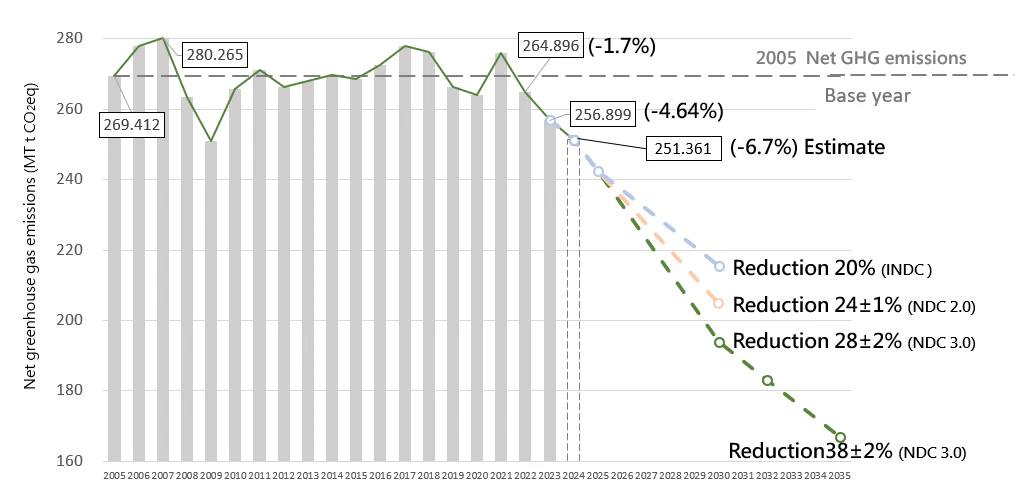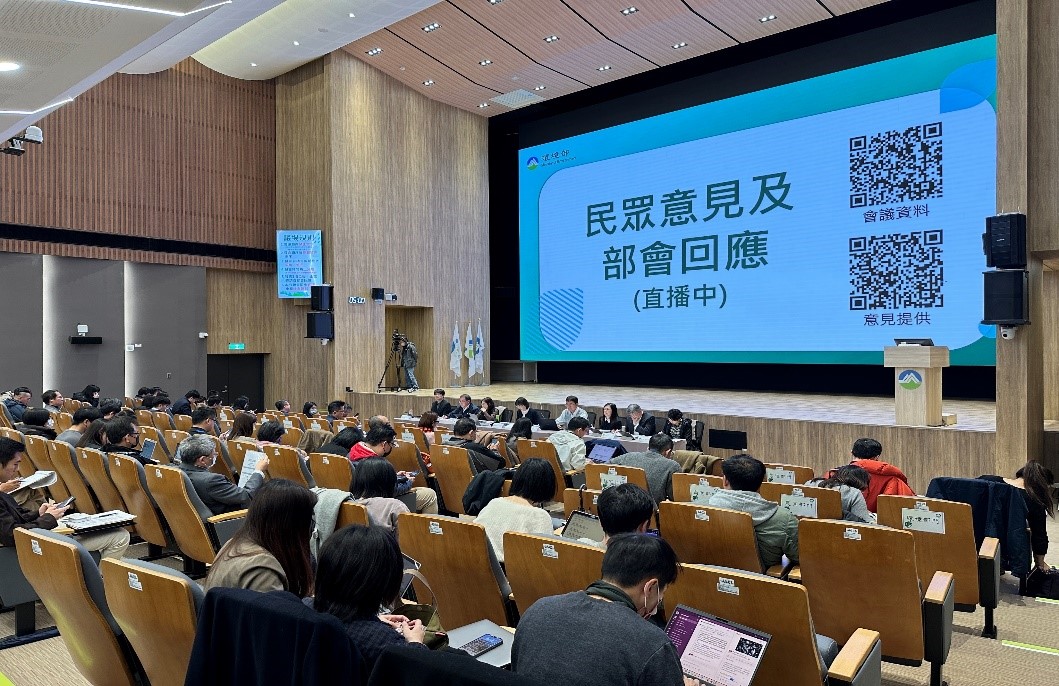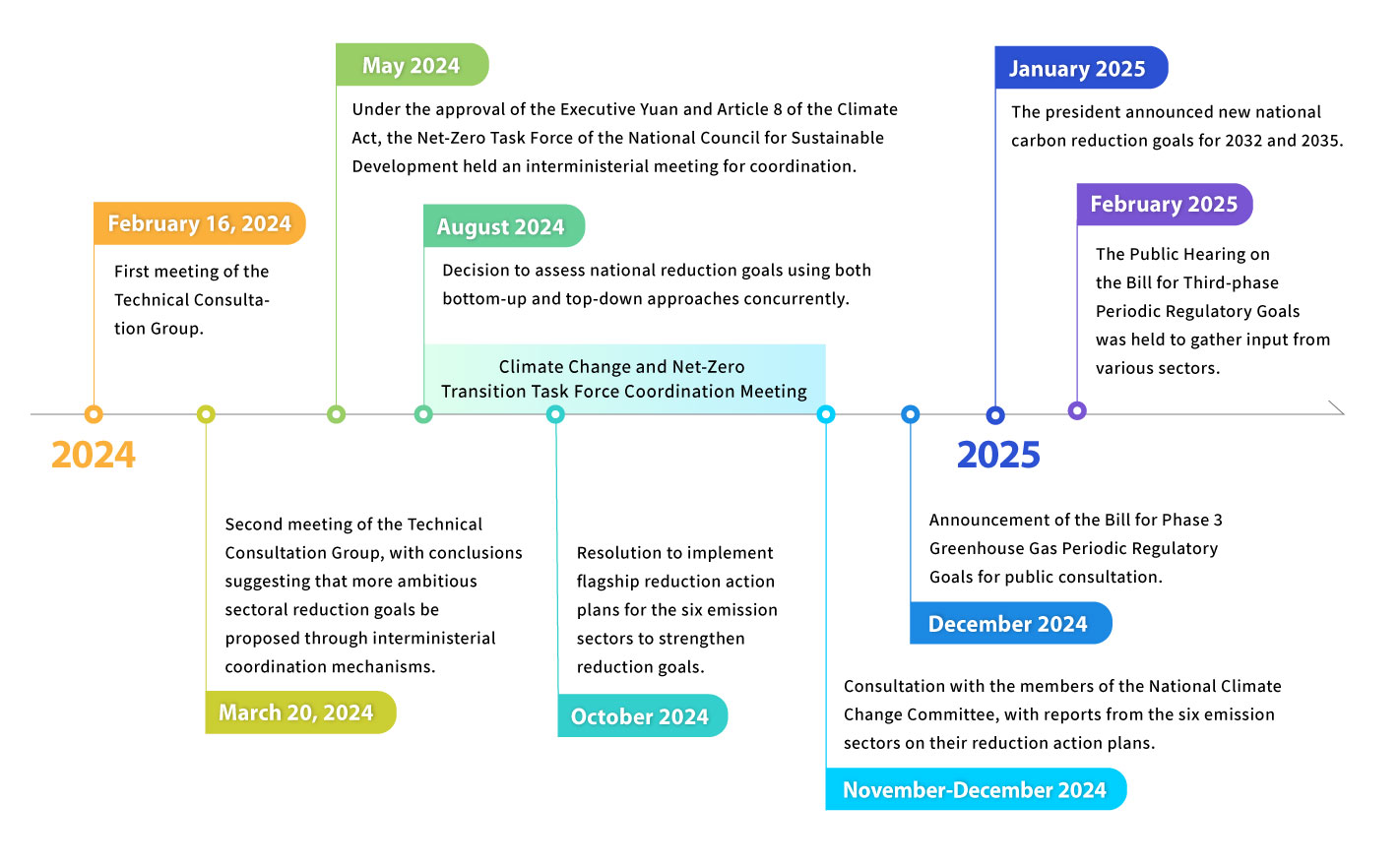
Taiwan's New Carbon Reduction Targets
- In 2024, the president introduced the "National Project of Hope," which explicitly defines "Green Growth and 2050 Net-Zero Transition" as a key policy objective. Five major net-zero transition strategies were set for continual implementation. In June 2024, the Presidential Office established the "National Climate Change Committee" to govern climate policies and promote international cooperation from a national development perspective. This committee includes representatives from industry, government, academia, and research institutions, strengthening the communication platform for climate change responses, accelerating policy implementation, and enhancing public participation.
- On Oct. 24, 2024, during a meeting of the National Climate Change Committee, the president announced an intensified climate action plan aimed at enhancing Taiwan's international industrial competitiveness and accelerating alignment with global Nationally Determined Contributions (NDCs). The president also called for a reassessment of 2030 climate goals with greater ambition to overcome challenges and set new carbon reduction targets for 2032 and 2035.
- On Dec. 30, 2024, the "Bill for Phase 3 Greenhouse Gas Regulatory Goals" was proposed, raising the 2030 national greenhouse gas net emission reduction target from the originally announced 2022 NDC of 24±1% below the baseline year (2005) to 28±2% below the baseline year.
- On Jan. 23, 2025, the president announced the draft of "Taiwan's New Carbon Reduction" at the National Climate Change Committee. The proposed targets aim for a 32±2% reduction by 2032 and a 38±2% reduction by 2035, compared to the baseline year (2005).

Taiwan's New Carbon Reduction Targets
Bill for Phase 3 Greenhouse Gas Periodic Regulatory Goals and Public Hearing
20241230 Phase 3 Goals and Expanded Inventory presentationPDF
- Legal basis: Article 10, "Climate Change Response Act"
- Date of proposal: On Dec. 30, 2024, the Ministry of Environment (MOENV) announced the Bill for Phase 3 Periodic Regulatory Goals on the Climate Info Hub website, as designated by the “Climate Change Response Act” (“Climate Act”). In addition, it held a livestreamed press conference and issued a press release to provide details.
- Bill contents:
- (1)National periodic regulatory goals: By 2030, net greenhouse gas emissions are targeted to be reduced by 28±2% from 2005 levels (198.980–188.225 MtCO2e).
- (2)Sectoral periodic regulatory goals:
Energy Sector
Emissions: 27.300 MtCO2e
Reduce 23.1% by 2030
(Base year: 2005)Manufacturing SectorEmissions: 117.377 MtCO2e
Reduce 18.0% by 2030
(Base year: 2005)Residential and Commercial SectorEmissions: 37.331 MtCO2e
Reduce 35.0% by 2030
(Base year: 2005)Transportation SectorEmissions: 30.373 MtCO2e
Reduce 20.0% by 2030
(Base year: 2005)Agriculture SectorEmissions: 5.226 MtCO2e
Reduce 35.1% by 2030
(Base year: 2005)Environmental SectorEmissions: 2.596 MtCO2e
Reduce 71.5% by 2030
(Base year: 2005) - (3)Periodic goal for Electricity Emission Factor (2030): 0.319 kgCO2e/kWh
The Bill for Phase 3 Greenhouse Gas Control Target
Current Periodic Regulatory Goals
- Public hearing results:
- (1)Time: Feb. 7, 2025 (Friday) at 2:00 p.m.
- (2)Location: Conference Hall, 2nd Floor, MOENV Rear Building (No. 156, Yanping South Road, Zhongzheng District, Taipei City).
- (3)Arrangements:
- 1. On Dec.30, 2024 (30 days before the hearing), the ministry notified relevant central and local government agencies, published the information on the Climate Info Hub website designated by the central competent authority under the "Climate Change Response Act Implementation Rules," and publicized it through the government gazette, a press release, and a press conference to raise awareness.
- 2. Due to the fact that registration for this public hearing has reached 200 participants, exceeding the venue's capacity, attendees were encouraged to watch the livestream instead. The livestream link was announced on the Climate Change Administration website the day before the hearing. Online submission of opinions was welcomed.
- (4)Public Hearing Agenda:
Public Hearing on Bill for Phase 3 Greenhouse Gas Periodic Regulatory Goals
- (5)Results: Nearly 800 participants attended either in person or online. The Ministry of Environment and six key sectors reported on the bill for Phase 3 Greenhouse Gas Regulatory Goals. Participants included representatives from industry associations, businesses, academic institutions, civil organizations, and youth. Additionally, legal and technical advisory groups as well as experts and scholars specializing in human rights and gender equality provided suggestions; discussions covered diverse topics including technical consultation, human rights, and gender equality, demonstrating a transparent and science-based dialogue. Through this open and transparent communication, a national consensus was fostered.
Public Hearing on Bill for Phase 3 Greenhouse Gas Periodic Regulatory Goals (video of livestream)

Public Hearing on Bill for Phase 3 Greenhouse Gas Periodic Regulatory Goals
Technical Consultation Phase
Establishment Guidelines
To strengthen the drafting process of periodic regulatory goals, on Nov. 22, 2023, the MOENV issued the "Guidelines for the Establishment of the Scholarly and Expert Technical Consultation Group for Periodic Regulatory Goals" under Article 10, Paragraph 1 of the “Climate Change Response Act.” The consultation group's primary tasks include predicting national and sectoral greenhouse gas emission trends, conducting reduction scenario analysis, and addressing other matters related to achieving long-term reduction targets.
Meetings
On Jan. 24, 2024, the MOENV established the Scholarly and Expert Technical Consultation Group for Phase 3 Periodic Regulatory Goals, which held two meetings on Feb. 16 and March 20, 2024. During these meetings, the group finalized the methodology for estimating sectoral greenhouse gas emission trends. They also provided consultation on various issues, including predicted trends in national and sectoral greenhouse gas emissions, reduction scenario analyses, and efforts to achieve long-term reduction goals. Their recommendations were then shared with all emission sectors for further evaluations and revisions.
Feb. 16, 2024 Technical Consultation Meeting MinutesPDF
March 20, 2024 Technical Consultation Meeting MinutesPDF
Interministerial Coordination Phase
With Executive Yuan approval and under Article 8 of the Climate Act, the bill was submitted to the Climate Change and Net-Zero Transition Task Force of the National Council for Sustainable Development for interministerial coordination. From August to December 2024, the task force convened 10 meetings, two ministerial strategic decision-making meetings, and three flagship program expert consultation meetings.
Coordination
- Coordination Mechanism
Top-down approach: the MOENV and the National Development Council projected the highest possible reduction goals from an overall national perspective based on Taiwan's 2050 net-zero pathway and 12 key net-zero strategies.
Bottom-up approach: The ministries in charge of the six emission sectors assessed and proposed carbon reduction goals, action plans, and identified related needs. - Ministerial Decision-Making and Breakthrough Approaches
The gap between bottom-up and top-down reduction targets will be addressed by the six major sectors through the development of 20 flagship carbon reduction action plans.
- Accelerating Carbon Reduction
Progress in six pillars: technological innovation, financial support, carbon pricing, regulatory adaptation, green workforce, and community-driven initiatives.
- The National Development Council has compiled the "Net-Zero Pathway: Taiwan's Comprehensive Carbon Reduction Action Plan."

Key Milestones for Setting Phase 3 Periodic Regulatory Goals 2024
Future Implementation Plans
Launch a social dialogue on "National Carbon Reduction Targets for 2032 and 2035" to build consensus and align with international standards. Before COP30 at the end of the year, propose Taiwan’s 2035 Nationally Determined Contribution (“NDC3.0”) to accelerate carbon reduction efforts and contribute to global climate governance.
In accordance with the “Climate Change Response Act,” once the Third-phase Greenhouse Gas Periodic Regulatory Goals are approved by the Executive Yuan, competent authorities must, within six months of approval and following public hearings, formulate and revise sectoral third-phase greenhouse gas reduction action plans. These plans will then be submitted to the central competent authority (the Ministry of Environment) and subsequently to the Executive Yuan for approval. At that time, broader public consultation will be initiated to foster social dialogue.
